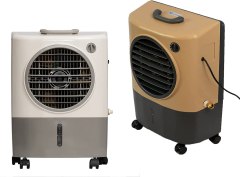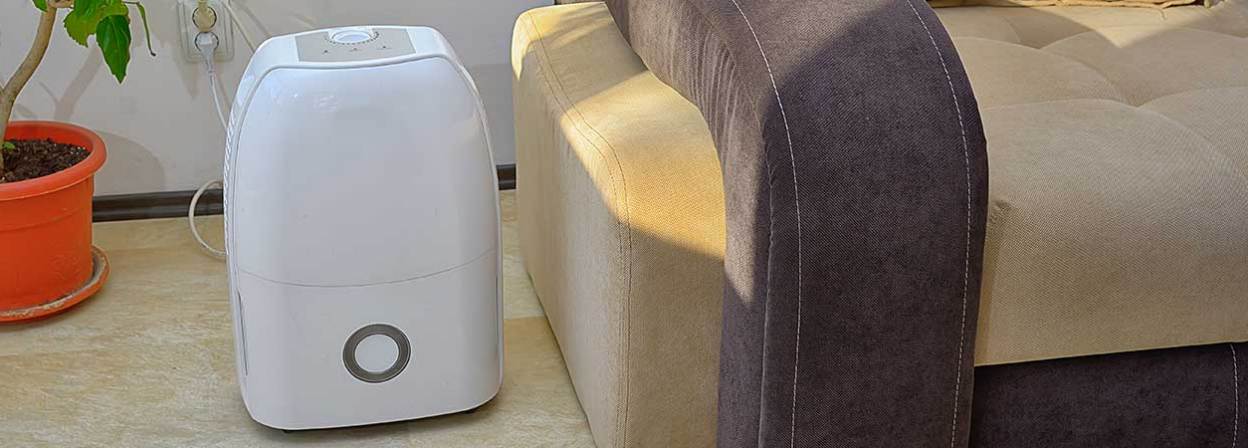BestReviews is reader-supported and may earn an affiliate commission. Details

This oscillating cooler can be tucked away in a corner and effectively cool and humidify the entire room.
This oscillating cooler can be tucked away in a corner and effectively cool and humidify the entire room.
The convenient top-loading design allows you to refill the humidifier without bending over or removing a large tank. Set on casters and equipped with a handle so it can be easily moved around the room. The 25-foot cooling and humidifying range is suitable for a small room.
This product can be noisy on higher settings.

An all-around model for at home indoors or on the patio; can attach to a hose for automatic filling.
An all-around model for at home indoors or on the patio; can attach to a hose for automatic filling.
Indoor/outdoor operation. Airflow rating at 1,300 cubic feet per minute. Can cool up to 500 square feet. Easy operation. Fills manually or automatically by attaching a garden hose with the included adapter. Has a non-cooling fan mode.
Not intended for extreme or all-weather outdoor use. No auto-shutoff.

This tower fan blows air at up to 22 feet per second.
This tower fan blows air at up to 22 feet per second.
It can blow as quietly as 20 decibels which is roughly as loud as rustling leaves. It has an 80-degree oscillation. The water tank, cooling pad, and grill are removable for easy cleaning.
It’s expensive. A full tank of water only lasts roughly 6 hours.

This portable cooler is great for those who roam about the home.
This portable cooler is great for those who roam about the home.
It has 3 wind speeds and will shut off if tipped over, for safety. An indicator light turns blue when the tank has water and red when it runs out. It has 60- or 120-degree oscillation.
It’s only powerful enough to cool 1 or 2 people sitting close to it.

A large, high-quality outdoor option that is designed for use in open rooms, decks, patios, garages, and backyards.
A large, high-quality outdoor option that is designed for use in open rooms, decks, patios, garages, and backyards.
Moves 1,062 to 1,471 cubic feet per minute up to 29 feet to cool over 600 square feet. Convenient ice compartment for extra cooling. Can be connected to a hose for continuous refill. Three-sided honeycomb media vents improve airflow.
The unit can run somewhat loudly.

We recommend these products based on an intensive research process that's designed to cut through the noise and find the top products in this space. Guided by experts, we spend hours looking into the factors that matter, to bring you these selections.

If you’re looking for a cost-effective, more environmentally friendly way to cool your home, an evaporative cooler is a great option. Also known as “swamp coolers,” evaporative coolers are designed not for humid conditions but rather for arid, dry, hot climates such as those found in the American Southwest and West.
Evaporative coolers fill a unique niche among climate-controlling appliances, offering efficient cooling in a package that is easier to install and less expensive overall. However, they do not work in every climate and may require you to refill the water tank frequently.
Not everyone is familiar with the benefits of the evaporative cooler and how it can save money on electricity while freshening and humidifying the air in your home, so you might be unsure how to find the right unit for your needs. Thus, before you go shopping, it helps to read a comprehensive buying guide about the best evaporative coolers to learn about size, type, and other important aspects of the appliance.

Unfortunately, evaporative coolers don’t work well in climates with more than 60% humidity, so they’re not a good choice east of the Mississippi or in parts of the Northwest, but they excel in dry climates. The lower the humidity level of the air in your space, the more effective an evaporative cooler will be. The past few years have seen a big increase in the number and types of evaporative coolers available. In short, there is an evaporative cooler to suit your needs and the space you want to cool.
Evaporative coolers are very effective at refreshing dry, stale air through their circulation process, which draws in dry air, passes it over moistened padding inside the unit, and then blows out slightly humidified, fresher air. It can lower the air temperature in a room or house by 5°F or more.
An evaporative cooler costs less to purchase than a traditional window unit or portable air conditioner. It also requires less energy to complete the cooling process since there’s no refrigerant compressor — just a fan and pump to circulate water. That means owners will pay less over the life of an evaporative cooling unit than they would for an air conditioner of similar size and power rating. In some cases, the savings can be as much as 50%, and some brands claim as high as 75%.
Air conditioners cool the air inside the home by drawing in warm air and passing it over an evaporator coil that has been cooled using a refrigerant (usually a hydrochlorofluorocarbon like R-22 or R-410A). This also removes some of the humidity from the air in the form of condensation. The drier, cooler air is then circulated back into the home. While it’s effective and popular, air conditioning uses more energy than evaporative cooling. The price of an air conditioner, particularly at a higher cubic feet per minute (CFM) rating, is often significantly more than an evaporative cooler, and it costs more in electricity to run over the long term.
Evaporative coolers are better for the environment than air conditioners in a handful of ways:
An evaporative cooler works best in arid and hot climates. In the right situation, it can cool the air by up to 20 degrees.
As with air conditioners, evaporative coolers vary in features such as fan speed, installation method, and extras such as oscillation and outdoor functionality.
There are two primary types of evaporative coolers: direct and indirect.
Direct: The most common and affordable evaporative cooling type, direct coolers pass air directly over or through water-saturated padding, returning cooler, humidified air to the room or house.
Indirect (or two-stage): A newer type of evaporative cooling, indirect cooling uses a secondary air stream that is pre-cooled, helping to cool down the primary air stream (the air that will circulate into the house) even more efficiently. This is a pricier unit, but it works very well in areas where daytime temperatures climb above 100°F.
There are two ways for an evaporative cooler to deliver cooled air: down flow and horizontal flow.
Down-flow coolers: The original evaporative coolers, down-flow (or down-discharge) coolers are mounted either on the roof or the side of a home. Air is drawn into the unit, cooled and moisturized, and then discharged downward into the living space.
Horizontal-flow coolers: These evaporative coolers blow cooled air horizontally into a home or room. The most common horizontal-flow coolers are portable units and window models, but ground-installed horizontal-flow coolers are becoming popular because they’re easier to access for maintenance.
Either way, make note of the cubic feet per minute (CFM) of evaporative coolers as you compare models, as this is the biggest factor in determining how much space a unit can effectively cool. One way to think of it is that the higher the CFM, the more frequently all of the air in a room is cycled through the cooler. This number usually falls between 500 and 20,000 CFM, but the easiest way to gauge efficiency is to check what square footage the manufacturer recommends for their cooler.
There are five common ways to use or install evaporative coolers: portable, window mounted, roof mounted, side mounted, and ground installed.
Some evaporative coolers are rated for outdoor use (often in addition to indoor use). Most of the time, they work best in semi-enclosed spaces such as garages, workshops, or screened-in porches. However, they can be effective in open spaces like patios if people are sitting close enough, and they work best on days with low humidity.

While evaporative air coolers are usually less expensive than air conditioners, they still range greatly in price depending on their efficiency and design.
For $100 to $500 are portable evaporative coolers for small spaces. While their air cooling power may not match that of mid-range models, many budget options are worth their price and may have extras like sleek bladeless designs or rechargeable batteries.
More powerful portable coolers and window-installed designs range in price from $500 to $750 and are usually sufficiently powerful to cool most homes. These can often output up to 3,500 CFM and have high water tank capacities.
Heavy-duty window and portable evaporative coolers, as well as permanent ground-installed coolers, cost from $750 to $3,000. Side and roof units fall into this range as well.
Note that using an evaporative cooler adds moisture to the air. For this reason, the technology is best used in dry climates rather than humid ones.

A. When shopping, pay attention to the cubic feet per minute (CFM) rating for the cooler, the airflow that a cooler can move. It’s important when figuring out whether a particular unit would cool your entire living space or just a room. Most brands list the estimated square footage that a specific unit will be able to cool, but you can also figure out what you need. Measure the length and width of the room(s) to get the square footage of the area you want to cool, and multiply that by the height of the ceiling. Divide that number by two. The result is the cubic feet per minute you’ll need to cool the area.
A. In some areas, the humidity in the air varies, and it might be higher from late night through early morning. The effects of the evaporative cooler may not be as noticeable at these times. Some homeowners run an air conditioner when the humidity is higher.
A. You should always follow the manufacturer’s instructions, as ice can damage some coolers. The right amount of ice can lead to more efficient cooling, but too much ice could cause the water to evaporate more slowly. This is because warm water generally evaporates faster. Whether you opt for ice or water, you will still get cold air as long as water is able to evaporate.
A. Yes. Unless you live in a severely dry climate, a dehumidifier will almost always boost the performance of your evaporative cooler.
Get emails you’ll love.
Learn about the products you’re wondering if you should buy and get advice on using your latest purchases.
